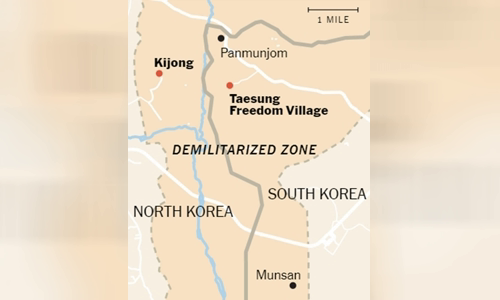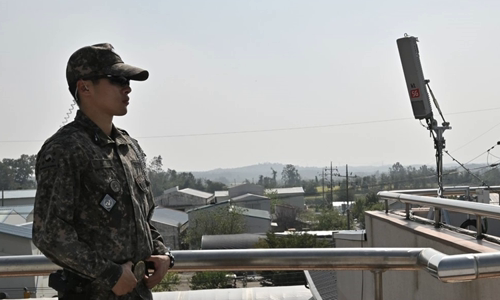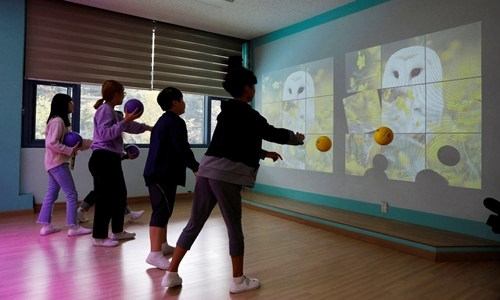South Korea188 Taesung villagers are subject to strict restrictions in the DMZ, but enjoy privileges such as tax breaks and exemption from military service.
This is considered a "reward" for Koreans who accept to live in Taesung Freedom Village in the Demilitarized Zone (DMZ) separating the two Korean peninsulas. Taesung is one of two civilian villages living in the DMZ, on the other side of the border is North Korea's Kijong Peace Village.

The location of Taesung Freedom village Photo: NYTimes
Taesung is often referred to by the Korean media as "the scariest place in the world", because it is located in the middle of the most heavily armed buffer zone in the world, with minefields and barbed wire fences, anti-tank trenches and Thousands of soldiers are always ready to fight on both sides.
Theoretically, North Korea and South Korea were still in a state of war because the 1950-53 Korean War ended with a truce, not a peace treaty.
The location of Taesung Freedom village. Graphics: NYTimes.
In the decades after the war, Taesung and Kijong became "pawns" in the propaganda war between the two peninsula. Today, Kijong is almost empty, pastel paints on apartments are fading, according to South Korean soldiers.
Meanwhile, South Korea strives to keep its people in Taesung, but faces many challenges as the villagers living here have to give up many of the freedoms and services that other Koreans take for granted.
Whenever the villagers arrived at the rice fields 400 meters from the border, Korean soldiers had to escort them. Villagers also had to obey curfew hours from midnight until sunrise and had to take attendance every night.
If wishing to invite friends from outside to enter the DMZ, the villagers must apply for approval two weeks in advance. When a vehicle enters the DMZ, the navigation map will no longer display any information. Soldiers must escort all visitors to the village.
Taesung doesn't have a gym, hospital, supermarket or restaurant. If the villagers want to order food to bring home, the last military checkpoint outside the DMZ is the closest place the delivery person can go. The food is left at this station for the villagers to pick up. There are 4 bus trips to the village every day.
"Traveling is the biggest headache, especially for people who do not drive like me," said Go Geum-sik, 73.

A Korean soldier stands near a 5G network antenna in the DMZ in September Photo: AFP
But in recent weeks, villagers have been given an extra privilege: South Korea's major mobile phone provider, KT Corp, has deployed 5G networks here, one of the first to be installed for any town or village in Korea.
"This network helps me more than my children. They all live outside the village," Go said.
With 5G service, Ms. Go simply presses the button on the phone to immediately alert the village leader or community center if she or her husband needs emergency medical assistance. "Calling 911 is useless because they can't come here," she said.
As South Korea strives to build one of the first nationwide 5G networks in the world, Taesung is an attractive installation site because South Korea can show its high-tech power to its neighbors and the rest of the world.
Before 5G, farmers had to ask soldiers to escort to the reservoir 1.5 km away to use a water pump. They can now activate pumps from home through smartphone apps. Also with this application, they can control the sprinklers in the field.
For many years, women wanted to attend yoga classes but no instructors came. Now yoga lessons are broadcast on the big screen in the community center room.
At the only school in the village, Taesung Elementary School, students can play interactive online games, they happily throw balls at virtual targets sliding down the wall.
Such facilities are an important factor to attract students. Like other rural villages in Korea, many young couples have left Taesung to go to big cities in recent decades. Today, only 7 of the 35 students at the school are natives in Taesung. The rest take a daily bus from Munsan, the nearest town outside the DMZ.
Students are well looked after because the school has 21 teachers and staff, while there are only 35 students. These factors and other incentives make parents in Munsan want their children to attend school.

Students play virtual pitches at Taesung village in September Photo: Reuters
"We enjoy a lot of things that other school friends don't have," said Heo Ye-rin, a sixth-grader living in Munsan. "When we participate in extracurricular activities, the family does not have to pay any costs because the government has provided it."
An American officer from the United Nations-led United Nations High Command organizes free English classes twice a week. "We hope that as the children grow up, they will have a good memory of the United Nations Command's soldiers," said Lt. Col. Sean Morrow.
Soldiers led by Morrow are responsible for protecting the Common Security Area (JSA) in the DMZ, including Taesung and Panmunjom, the border village where no civilians live. That's where North Korean leader Kim Jong-un met South Korean President Moon Jae-in in April last year and with President Donald Trump in June.
Diplomatic efforts have helped ease tensions along the border. Today, Taesung looks like any other rural village in Korea, with golden rice fields under the sun.
"But don't let your outward appearance fool you," Chun In-bum, a retired South Korean military general, said in a statement, stressing that North Korean soldiers watched the movements of the guests from the outside. "This is not a normal place. This is a place where dedicated soldiers try to ensure peace."
The people of Taesung are the ones who feel the most ups and downs in inter-Korean relations. Decades ago, villagers sometimes stepped on mines left from wartime or even kidnapped by Korean soldiers. When tensions are high, they are often evacuated from fields to underground bunkers.
Despite recent thawing of Korea-Korea relations, the villagers still rehearse evacuations twice a year. The two countries agreed to turn off the propaganda speaker system pointing to each other at the border. "Although the political leaders say that the tension has eased, we still feel it because the military is always facing each other," said Kim Yong-sung, 49-year-old bean farmer.
When the Korean-Korean leader met at Panmunjom, two Taesung Elementary School students gave flowers to greet Mr. Kim. "I'm scared but also curious about North Korea's leader," said Sin Jae-hyeok, one of the two students. "After meeting Mr. Kim, his image in my mind improved a bit."



 RodicaLiliana
RodicaLiliana







